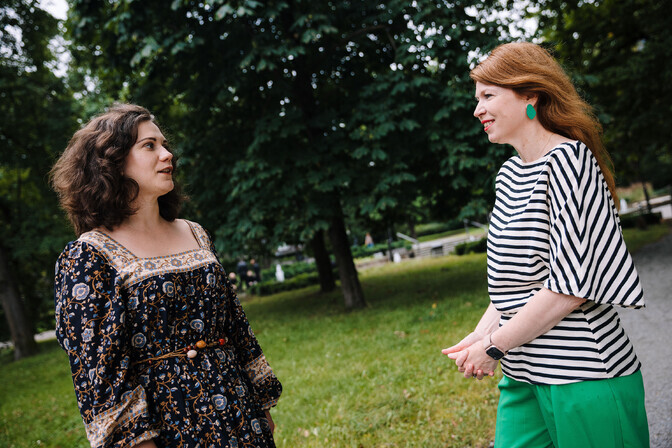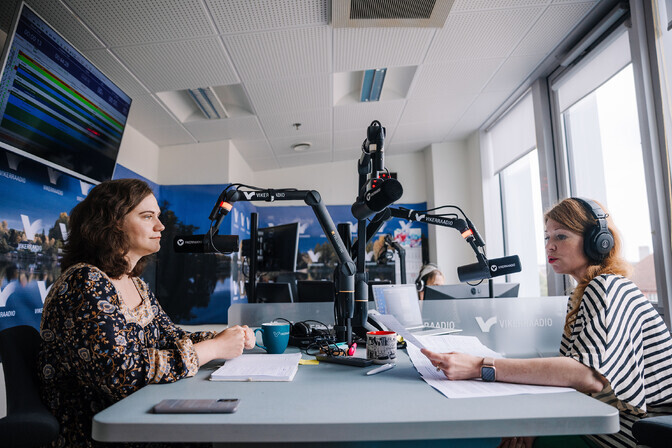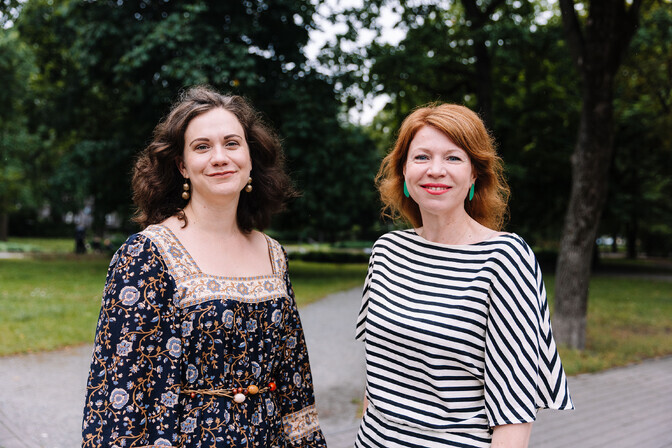Four thoughts from Bogáta Timár:
- Collaboration between scientific disciplines is opening new perspectives on Finno-Ugric origins. The conclusions of genetics, archaeology and linguistics are increasingly aligning, creating a more comprehensive picture of our ancestors’ migrations than before. This shows that while new discoveries — such as the homeland being located east of the Urals — do not change the language family tree, they help place it in a broader historical context.
- The vitality of small and minority languages depends not only on the number of speakers but also on their cultural use. The greatest threat to language preservation comes when parents no longer teach it as a mother tongue to their children. At the same time, the example of the Livonian language shows that even if there are only a handful of native speakers, a language can continue to thrive through songs, literature and community events.
- Modern pop culture is an important tool for keeping minority languages alive and making them attractive to young people. Instead of turning inward, vibrant minority cultures can adapt and find expression in contemporary forms, such as Mari rap, Udmurt techno music or internet memes. This kind of recontextualization of language and culture makes it alive and relevant for younger generations, ensuring its continuity.
- Hungary’s political situation and the suppression of academic freedom are forcing intellectuals to leave the country. Orbán’s regime has systematically restricted universities’ funding and independence and turned state media into a propaganda channel, making free thought and research difficult. Deepening social polarization and a constant climate of disinformation have created an oppressive mental environment, prompting many — especially young people — to seek a better future elsewhere.
My guest today is Bogáta Timár, a scholar who emigrated from Hungary to Estonia and now works at the University of Tartu. She is a Finno-Ugric philologist, so we will be able to discuss the state and vitality of Finno-Ugric languages, research related to Finno-Ugric languages and culture, learning and speaking Estonian as a foreigner and, of course, the political situation in Hungary.
This summer, a scientific finding suggested that the original homeland of Finno-Ugric language speakers might not have been the Ural Mountains, but thousands of kilometers farther east in Yakutia. How significant is this news for philologists and linguists and what could this new knowledge bring to the study of Finno-Ugric languages?
For linguists, this is not particularly significant news, because it does not concern the language family tree. Genes tell us nothing about language, but it is still quite interesting and important. Until now, it was assumed that the Proto-Uralic language developed somewhere on the Asian side of the Ural Mountains, in Western Siberia. Now it turns out it was probably farther east. This does not make us more Yakut. In fact, it had already been assumed that a tribe that came from the east about 4,500 years ago and came into contact with Indo-Europeans in Western Siberia might have been a Uralic people. Now this has been confirmed through genetic evidence.
You are a Finno-Ugric philologist and linguist. In this field of research, what is currently relevant or popular to study and what aspects are still waiting to be explored? Could this recent news about Yakutian origins be one example that characterizes the research being done in this area today?
Of course, when the question is where we come from, who we are and where we originate, the current star of the sciences is genetics. A couple of years ago, some very interesting studies were published by Estonian researchers. They released research in the journal Nature that was also related to genetics and proved a link between Hungarians and the Khanty and Mansi peoples. What we are now seeing is an even deeper layer — we have reached the Proto-Uralic level.
From a linguist’s perspective, I find it fascinating how the conclusions of genetics and linguistics are starting to align. Geneticists talk about a tribe that lived somewhere about 4,500 years ago and the Uralic language emerged about 4,500 years ago — somehow it all comes together. At the same time, there have been some very interesting archaeological discoveries from the Ural Mountains in the past five or six years that are rewriting the history of the Hungarian people’s migration into the Carpathian Basin. So archaeology, linguistics and genetics are finally beginning to work together.
Naturally, there are still interesting questions within linguistics itself, but these tend to be more detailed. For example, there is the question of the Proto-Ugric language within the Uralic family tree. The Ugric languages are Hungarian, Khanty and Mansi. Did they have a common Proto-Ugric language or not? There is currently no consensus on that. Sometimes, entirely new theories are put forward — for example, that the Uralic languages might have an entirely new branch.
 Bogata Timar and Merilin Pärli. Source: Ken Mürk/ERR
Bogata Timar and Merilin Pärli. Source: Ken Mürk/ERR
A few years ago, there was also talk that Hungarian might not actually belong to the Finno-Ugric language family. Scholars have been constantly revising their positions. Has Hungarian now been rehabilitated after all?
Hungarian has never been removed from the Uralic language family tree. It’s just that Hungarians find it a bit difficult to grasp the whole concept, since they are so isolated there in the Carpathian Basin. It is hard to sell them the idea that they are Finno-Ugric. But it was proven more than a hundred years ago that Hungarian is, in fact, a Finno-Ugric language. Although many Hungarians don’t like that fact, scholars remain in full agreement on the matter.
Why don’t Hungarians like that?
By the time they arrived in the Carpathian Basin, they had already undergone Turkic influence. They looked and behaved like a Turkic people and their language contains a great many Turkic loanwords. In fact, Byzantine sources even referred to them as Turks. So when, about 200 years ago, some bothersome scholars began saying that their kin were the Sami, Estonians and Finns, they were not exactly thrilled by the idea that their relatives supposedly smelled of fish.
So where exactly was that point of contact, when did it happen and what has remained in the Hungarian language from that contact that proves we are part of the same language family?
We always have to look at our oldest words and grammatical structure. The fact that Estonian has kummimadrats and Hungarian has gumimatrac or that Estonian has käsigranaat and Hungarian has kézi daru, is not the proof.
Once, in a restaurant, a waiter came up to my colleague and me and asked what language we were speaking. I asked if he wanted to guess. He said he’d rather not. When I told him we were speaking Hungarian, he replied, “Ah, I would have guessed that, because I know we have words in common.” I thought, how well-educated this waiter must be. Then he said, “kummimadrats.” I laughed at that rubber-mattress joke a bit too much. In fact, käsigranaat is a better example, because it contains the word käsi, which is kéz in Hungarian.
So, we’re rather talking about very archaic words, like “water,” “blood,” “hand,” that sound similar?
Yes, and “fish” (kala). These are usually words for body parts and concepts connected to life and death. For example, “to live” (elama) is élni in Hungarian, and “to go” (minema) is menni. You can piece things like that together. Of course, the grammatical structure is also similar: we have cases instead of prepositions and no grammatical gender. Features like these tend not to change much over the course of centuries or even millennia.
How many thousands of years ago did these shared words originate?
The Uralic roots are at least about 4,000–5,000 years old, although we don’t know exactly, as we have no written sources. The Finno-Ugric roots are about 3,000 or 2,500 years old. The ancestors of Hungarian and Estonian split from each other quite early on.
Considering that the Estonian National Museum’s only permanent exhibition on Finno-Ugric peoples is called “Echo of the Urals,” does this news about Yakutia make the title outdated? Given that the exhibition was set up almost ten years ago, how much has science advanced in that time? Could there be elements in it that, from a scientific perspective, are outdated and in need of updating?
“Echo of the Urals” is, in my opinion, still a perfectly fine name, because these are still Uralic languages. In any case, what used to be called the Yakut language is now actually referred to as the Sakha language — the name “Yakut” could well be forgotten.
As for what’s outdated — about a week ago, I visited “Echo of the Urals” and ended up giving an impromptu guided tour. There’s one screen about genetics that is already a bit out of date. The population figures there are based on a census taken 15 years ago, which has two problems: first, it’s old, and second, it’s a Russian census, meaning the data is not particularly reliable. There has since been another census, but even in academic work we don’t really use that data, because it’s not trustworthy at all.
If we subtract the Hungarians’ huge population, how many Finno-Ugric peoples are actually left?
Finland has 5.5 million people, Estonia has 1.3 million and in Russia there are about 1.5 million Finno-Ugric people in total. It depends on how we define a “people.” Do we mean native speakers of the language or also those who identify as, say, Erzya or Mari, but perhaps no longer speak the language?
 Bogata Timar. Source: Ken Mürk/ERR
Bogata Timar. Source: Ken Mürk/ERR
Of those roughly 1.5 million Finno-Ugric people living in Russia, how many might still speak their native language? Is that known?
It can be estimated that about two-thirds still speak their native language. But the real issue is not just numbers — it’s whether the language is being passed on to the next generation. Even if a people is small, if the language is passed down, it remains viable. Unfortunately, we see that it is no longer a given that this transmission will happen.
I was doing fieldwork in a Mari village in Mari El — there were a couple of Tatars living there, but otherwise only Maris. Three generations all spoke Mari, yet there was a woman with a small child in her arms and she spoke to the child only in Russian. I thought: we are in a Mari village, everyone here speaks Mari, your child is neither a foreigner nor Russian — why are you doing this? I wouldn’t say everyone does it, but this trend exists and that is where the problem lies.
In Russia, Finno-Ugric peoples cannot receive an education in their native language. Under such relatively repressive conditions, how long can a language survive if it is spoken only within one’s own village?
I don’t know how to answer that — how many years or what kind of forecast could even be made?
Looking back in history, how quickly have these languages declined in terms of the number of speakers?
The decline is usually not linear — at a certain point, it speeds up. A language can sometimes survive if it has, for example, a ritual function. The Mari have managed to preserve their language relatively well, but they also have their native form of paganism, which is conducted entirely in Mari. When that disappears, the language usually disappears with it.
This can be seen clearly in the case of Karelian. In about 15 years, roughly half of all Karelian speakers have vanished — they simply passed away and the younger generation no longer speaks it.
A Finnish linguist — an extraordinarily handsome young man — once went to a village in Karelia and knocked on a door. An old woman opened it. The young man greeted her in Karelian. She went completely pale and slammed the door in his face. Later, after she had calmed down, she explained why. She knew she was part of the last generation to speak Karelian. So when a divinely handsome young man suddenly knocked on her door and greeted her in Karelian, she thought she had died and an angel had come to take her away. It’s a funny story, but also not — it’s a little sad that things happen this way.
Real-life tragedy. A couple of weeks ago, during vacation, my daughter and I visited the old Livonian areas in present-day Latvia. Along the coast there are these old Livonian villages and the Latvian state is now trying to help revive Livonian culture and language. For example, village names are bilingual and there are Livonian cultural centers. One of them is in Mazirbe village, or Irēs in Livonian.
This cultural center also houses a pizzeria. We went in, and all the signs were bilingual, including polite expressions in Livonian. My daughter, who is teaching herself Livonian, immediately placed her order in Livonian. To our surprise, the server at the pizzeria in the Livonian cultural center basically scolded her, saying she didn’t speak Livonian and didn’t have to, because it’s a dead language. She said the last Livonian, who lived in the neighboring house, died a few years ago. Once a year, on the first Saturday of August, Livonian language enthusiasts gather in the village — that day is tomorrow again — and pretend they can speak Livonian, but in reality it’s a dead language. So what is the actual state of Livonian? Is it a dead language and can attempts to revive it bear fruit?
At the last World Congress five years ago, the Latvian representatives promised they would do everything possible to preserve the Livonian language. When we talk about a language, it’s important to remember that it can have a role or meaning beyond being someone’s first language or everyday means of communication. It’s true that the last fully fluent Livonian speaker died in Canada in 2013.
But that did not mark the end of Livonian use. A dead language is one that no one speaks anymore and that has no remaining significance — essentially, it has been forgotten. Livonian, however, is still used for writing poetry and creating vibrant music and it is celebrated at the annual Livonian festival — which, if I understand correctly, takes place this Saturday.
In fact, there’s a young couple living in Helsinki who speak only Livonian with their child, so now there is once again someone in the world for whom Livonian is a native language. Of course, we can’t expect a huge number of people to suddenly start speaking Livonian as their first language, but there are about 30 people who speak it well and a few hundred who have learned it, studied it or are otherwise connected to it. There’s also a Livonian language camp and on the first Sunday after the spring equinox there’s a Livonian Heritage Day.
You mentioned those signs. Just last week, all the Livonian villages received Livonian-language signage. This linguistic landscape — seeing things written in Livonian — is a very important part of language revitalization and heritage preservation, helping to ensure the language is not forgotten and to show that Livonians existed and that their descendants are still here.
What’s happening with Livonian right now is very interesting. Interest in it is steadily growing, partly because of changes in research focus — since traveling to Russia is currently not ideal, more attention is being turned toward the Livonian language.
 Bogata Timar. Source: Ken Mürk/ERR
Bogata Timar. Source: Ken Mürk/ERR
Has Livonian been receiving more scholarly attention and interest because the Finno-Ugric languages in Russia are now relatively inaccessible to researchers?
It doesn’t mean researchers have suddenly been retraining en masse to study Livonian, but let’s say it’s now a bit more pleasant to be a Livonian scholar. I have a friend who studies language policy and Livonian-language music and she also visits the Livonian Coast. She tells me how one old lady said this and another said that — a kind of “old ladies’ drama,” with all sorts of wonderful fieldwork stories.
I remember how nice it was when I could tell similar stories from my own fieldwork in Mari El or Udmurtia — but that doesn’t happen for me anymore. I can’t go to Russia now. I’m not even sure I’d get a visa, because I have a small criminal record.
Our listeners will definitely want to know about that.
I almost said I didn’t break the law — but I did. I went there to do language research on the wrong visa. On a tourist visa you’re not allowed to go to a university or conduct research, but I didn’t know that.
Already on the train, an FSB officer dressed in black came over to check my visa and ask a few questions. Then I went to the university and was welcomed without any problems the first day. But on the second day, when I started handing out questionnaires in Mari — I’m a Mari language researcher — the police knocked on the door. They told me I had the wrong visa and had to go with them to the police station.
It was actually kind of funny, because I didn’t speak Russian very well at the time, but I spoke Mari quite well, so they needed a translator to explain everything I had done wrong. People were watching this little circus of a Hungarian needing a Mari-language interpreter. I got a small fine, but they practically chauffeured me back to the university afterward, and I was able to continue my research. For police officers, they were actually quite nice — but yes, now I have this criminal record that says I’m a bad person.
Earlier, you mentioned that Hungarians aren’t too eager to acknowledge their Finno-Ugric roots. So where did your own interest come from in becoming a Finno-Ugric scholar and specifically in learning and researching the Mari language?
I think I’ve always been interested in languages and language families. Some listeners might relate to this — when you’re given a map, you can spend half an hour studying it. As a child, I was fascinated by all those maps, the data, the colors. Of course, I noticed on the map of Europe that almost the whole continent was one color, but Hungary and Finland were a different color. Why was that? Why were we so special? That’s what sparked my curiosity.
As a teenager, I got into Finnish metal music — which maybe some people can relate to — and I started traveling to Finland and learning Finnish. But it was so boring that I eventually dropped it.
At university, though, I had the opportunity to attend a Finno-Ugric youth conference in Syktyvkar, in the Komi Republic. There I saw firsthand how lively and vibrant the Finno-Ugric world really is. When we think of Finno-Ugric peoples, we might picture older villagers in ever-shrinking communities. But what I saw was a huge crowd of young people, Udmurt pop music — it opened my eyes. I thought: I don’t know exactly what this is, but I want more of it. I switched my major to Finno-Ugric linguistics and I’ve been a Finno-Ugric researcher ever since. I have no plans to stop.
So it’s not accurate to say these are dying languages? In many of them, youth culture is alive — and if there’s youth culture, then the language can develop and the culture won’t die out. Is that correct?
Yes. A language and culture have two options. One is to close in on itself and preserve itself that way, like an island culture with no contact with the outside world.
The other option is to develop along with the world. That’s something I really love — when I see, for example, Finno-Ugric meme culture, Finno-Ugric TikTok videos, Mari rap, Udmurt techno and all sorts of other things that are modern but recontextualized within a minority culture. I think that’s incredibly cool. I listen to Finno-Ugric music all the time.
This brings us neatly to Hungary. You weren’t born in Estonia — you moved here from Hungary. How long have you been living in Estonia now and what were the reasons you decided to move here?
I’ve been here for five and a half years. I came just before COVID, in February 2020. This question of “why Estonia?” is starting to surprise me a little — I get the feeling Estonians are still amazed when someone chooses Estonia as their new home. Why not? It’s actually a pretty nice place to live. There aren’t many people, there are four seasons, even summer is bearable, the school system is good, hospitals aren’t falling apart, press freedom is apparently number one in the world, number one in Europe on the PISA tests, human rights are well-protected, bureaucracy is simple and the cities are beautiful.
 Bogata Timar and Merilin Pärli. Source: Ken Mürk/ERR
Bogata Timar and Merilin Pärli. Source: Ken Mürk/ERR
Of course, I doubt you ran through all the indicators and made a purely rational decision when choosing a new home. There must have been other factors — perhaps even the fact that it’s also a Finno-Ugric cultural and linguistic environment.
Estonia really is a great place to be a Finno-Ugric researcher. I always say Estonia is somehow the center of the Finno-Ugric world and it’s where the most attention is paid to it.
What were the reasons you left Hungary? Were they political?
Some of the reasons were political. When a country starts turning authoritarian, you can predict the kinds of things that will follow. Independent research is not usually something autocrats are fond of. If not immediately, then over time you can expect action to be taken against it — and that’s exactly what happened. Funding for research institutions was cut and there were attempts to control what could be studied. University funding was transferred to foundations, which led to Hungary being hit with heavy sanctions.
Now the situation is quite grim: most Hungarian universities can no longer take part in the Erasmus program. I think that’s awful — science simply can’t function when there’s no academic freedom. I knew the situation was unlikely to improve much.
Human beings are a bit strange in that, when a country becomes more authoritarian gradually, they tend not to notice. But if you look back at how things were five or ten years ago, the change is absolutely enormous. It’s also worth looking ahead — if the trend continues, what will the situation be like in five years? If someone has already managed to do so much damage to their country, they won’t stop out of moral scruples.
Hungary was also an Eastern Bloc country during the Soviet era, so Hungarians should still have that painful memory in their blood. National sovereignty is at risk if you’re too friendly with Russia. Does Viktor Orbán have absolutely no national instinct for self-preservation or why does he flirt with Russia?
Estonians and Hungarians had very different experiences with the Soviet Union. Hungary was more or less autonomous and life there wasn’t so bad that people remember it as something truly terrible.
As for why Orbán likes Putin, the answer is simple: one autocrat likes another autocrat — they understand each other. They usually don’t have a moral compass; they just want to stay in power as long as possible. Their goal is the same. Orbán’s natural ally is someone who thinks the same way. They can talk all they want about traditional values, but in reality they’re not conservatives — they’re simply autocrats.
What are the societal changes that, looking back, make you say the situation has drastically changed over these years?
One of Orbán’s biggest successes has been the suppression of the media. He has effectively shut down the most important outlets that weren’t under his direct control. State media is filled with Fidesz propaganda. This affects society constantly — even people who oppose Orbán. When you hear that propaganda everywhere — at the hairdresser’s, in a restaurant, in a taxi — it still gets to you. It makes people angry, puts them in an uncomfortable position. People are simply less happy.
Another problem is that Hungarian society is deeply polarized. One side strongly supports Orbán and the other strongly opposes him. It’s a serious issue when you no longer speak to a coworker or a neighbor because they’re on the opposite extreme.
What do Orbán’s supporters value in him? Why do they prefer today’s Hungary over the earlier, freer Hungary?
One thing is that they believe Hungary is just as free as before — only now it’s standing up more for its self-determination. Even before the war, Orbán was already popular among certain parties because they felt he was somehow resisting the European Union. They see that as a major threat and he’s protecting them from it. Orbán is the freedom fighter who says “no” to Brussels.
Another factor is that they believe what Orbán tells them: that he stands for traditional values and isn’t interested in any rainbow politics coming from the West. They believe the real threat is in Ukraine and that Putin is actually just fine.
It’s absolutely wild that they’ve managed to reframe the 1956 uprising ideologically. Now the story goes that those who crushed the uprising were Ukrainians, because there were many Ukrainians in the Red Army. So the claim is that it was the Ukrainians’ doing.
 Bogata Timar. Source: Ken Mürk/ERR
Bogata Timar. Source: Ken Mürk/ERR
Do you believe the course Orbán has taken is still reversible? Can Hungary still become a Western-oriented country again?
Right now, Hungary is in an interesting moment. Next year there will be elections and expectations are running very high. Orbán has gained a real opponent who has become immensely popular — we’re talking about Péter Magyar. For several months now, he’s been ahead of Orbán in the polls, especially among young people who will be voting for the first time. Even in small towns, people have grown tired of Orbán; the money has run out and life is no longer so pleasant. It’s genuinely very likely that Orbán’s party will not win the next election.
You believe the elections will be fair and the votes won’t be counted the way they are in Russia?
Yes, I do. My own mother was a vote counter in the last election, as were several of my friends and acquaintances. The process is actually very tightly regulated and it would be extremely difficult to falsify the results the way it’s done in Russia or Belarus. I don’t believe there will be manipulation of the vote count.
How many Hungarians might have left the country because of Orbán’s policies?
I can’t give a precise number, but it’s a lot. Especially young adults without children, families or other commitments and who have at least a bit of financial cushion. There are even support groups on Facebook where young people help others move abroad. It’s safe to say that directly because of Orbán’s policies, at least a couple of tens of thousands have left.
How many of them might have come to Estonia? Has a small Hungarian community already formed here?
Maybe there is, although it’s not very strong. I live in Tartu and there isn’t a large Hungarian community here, but I’m sure it exists. I’ve taught Estonian to Hungarians who have moved here and just last week two of my very good friends from Hungary relocated to Estonia. They genuinely want to stay, already speak Estonian quite well and want to build their lives here.
How long did it take you to become so fluent in Estonian? And how easy is it to actually speak Estonian in Estonia — do Estonians let you do it?
They do now. When my accent was stronger or my vocabulary smaller, I had to push a bit to keep using Estonian, because sometimes people would switch to English. That happens less and less these days.
My advice to all Estonians is this: if a foreigner starts speaking Estonian to you, answer them in Estonian. They probably have very good reasons for choosing that language. We usually know that Estonians speak English, so it’s not that we assume you can’t — we just want to practice our Estonian.
I learned Estonian over the course of seven years. I already spoke Finnish when I started and that probably helped a bit. Estonian really isn’t impossibly difficult — if you have the motivation and the right environment, it’s absolutely possible to learn.
If we compare Estonians and Hungarians, beyond those few very archaic shared words — and the kummimadrats — do we have anything similar in our character or beliefs? Are Hungarians also foragers like Estonians, going to the forest for mushrooms and berries and holding an animistic worldview or does the similarity end with those few words?
I’d say we share a bit of the same Eastern European outlook. We have, in some ways, a similar history of trying to survive between great powers — sometimes in better times, sometimes in worse. I wouldn’t say Hungarians are as much into foraging or animism as Estonians are; that’s more of an Estonian thing. But Hungarians do love singing in choirs.
Do you sing in a choir yourself?
I have a Finno-Ugric band. That’s how I express my urge to sing.
Finally, you provide foster care for cats in Tartu — looking after those without a permanent home until they find one. What language do you speak to these cats — Estonian, Hungarian or Mari?
These cats are already polyglots — Estonian, Hungarian, not so much Mari, but my partner speaks to them in Seto. (Laughs.)
What language do you think in?
More deeply in Hungarian, but quite often in Estonian when it comes to everyday matters.
Is Estonia still a foster home for you or is it already a permanent home? Have you put down roots here and no longer expect to ever move back to Hungary?
I don’t plan to move back to Hungary — not because I hate Hungary so much, but because I love Estonia so much. I consider myself incredibly lucky to have found a country where I feel so good. I may never become a full-fledged Estonian, but over the years I find myself becoming more and more like one.
Thank you for joining us on the program, Bogáta Timár!
Thank you!
 Bogata Timar and Merilin Pärli Source: Ken Mürk/ERR
Bogata Timar and Merilin Pärli Source: Ken Mürk/ERR
—
Follow ERR News on Facebook and X and never miss an update!
